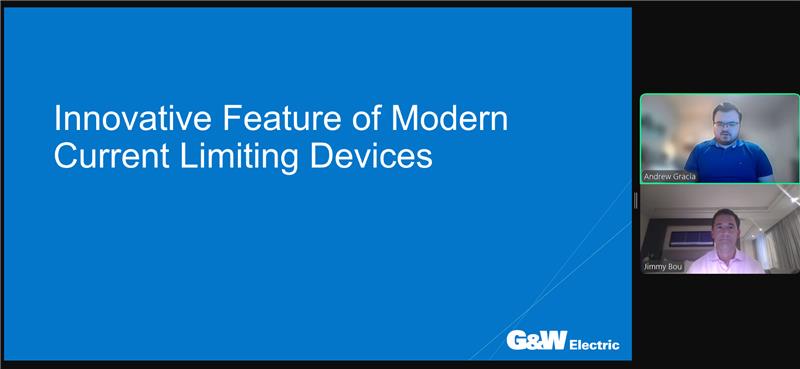Latest News
Subpage Hero

Managing Rising Fault Levels in Modern Power Systems

Watch the full webinar below.
As the demand for reliable electricity grows and power systems become more complex, grid infrastructure must evolve to keep pace. One emerging challenge is the increasing level of short circuit faults in electrical systems. These rising fault levels can result in costly equipment damage, extended downtime, safety hazards, and, in severe cases, risk to human life.
Limitations of Traditional Protection Methods
Conventional protection devices such as fuses and reactors remain common in many systems but come with significant drawbacks. Backup and current-limiting fuses are inexpensive, easy to maintain, and widely available. However, they require replacement after each operation, are typically rated up to 600 amps, and have fixed Time-Current Characteristic (TCC) curves, limiting their flexibility and effectiveness.
On the other hand, reactors, which are used to limit current magnitude or neutral grounding, support higher ratings but are bulky, can degrade power quality through voltage sags, and reduce power efficiency due to added impedance.
Overall, traditional protection methods, while still widely used, may no longer offer the necessary protection for today’s rapidly changing energy environment.
Emerging Technologies for a Smarter Response
To overcome these limitations, a new generation of current limiting technologies is emerging. These devices provide faster fault detection, shorter fault duration, and better control of fault energy. Among the most promising solutions are solid-state breakers, superconductors, and Current Limiting Protectors.
Solid-state breakers use semiconductor technology to interrupt faults in microseconds, often in less than half an electrical cycle. This fast response significantly reduces both fault magnitude and duration, helping to eliminate arc flash risk. They offer enhanced lifespan, control, and low-level fault protection. However, they are expensive, limited in available ratings due to size, and often non-serviceable.
Superconductors are another advanced option, using near-zero resistance materials cooled to cryogenic temperatures. As resistance increases sharply during faults, current is quickly limited. These systems are highly efficient and support high current densities but require long cable runs, cryogenic systems, and come with high installation and maintenance costs. Their most common use is in HVDC transmission systems.
CLiP® Current Limiting Protectors, developed by G&W Electric, offer a practical balance between modern performance and operational simplicity. Using a contained pyrotechnic device, CLiP current limiting protectors divert fault current through a limiting fuse and clear faults in 1/4 to 1/2 a cycle. In normal conditions, they conduct through a low-resistance copper bus bar, activating only in severe fault conditions. CLiP current limiting protectors are available up to 38 kV, are relatively cost-effective, and are designed to avoid nuisance trips. However, they are not suitable for low-level fault protection and are slightly less effective than solid-state breakers in limiting arc flash.
How These Technologies Compare
When comparing cost, complexity, and performance, CLiP current limiting protectors are the most affordable and least complex, followed by solid-state breakers and superconductors. Solid-state breakers lead in fault detection speed, arc flash mitigation, and low-level fault protection. Superconductors outperform in power efficiency and capacity but rank lowest in cost and complexity.
Choosing the right solution depends heavily on application needs, operating environment, and available resources.
Real-World Applications and Use Cases
Modern current limiting devices are already helping facilities safely extend the use of lower-rated equipment, reduce arc flash risk, and improve system flexibility. For example, CLiP current limiting devices have been used to bypass bulky reactors in nuclear plants, limiting voltage drops during normal operation while maintaining fault protection. In wind farms and cogeneration systems, they offer added protection and improved system isolation during disturbances like earthquakes.
To get the most out of these technologies, early planning is essential. Engineers should factor in downstream inrush currents, coordinate devices to avoid unnecessary operation, and understand system-specific requirements. Proper integration with other protective elements ensures that these current limiting devices activate only under severe fault conditions.
Looking Ahead: Trends Shaping the Future
With the rapid expansion of data centers, renewable energy, and decentralized grids, fault current levels are expected to increase. As a result, technologies like solid-state breakers, superconductors, and CLiP current limiting protectors will become more common. Each offers unique advantages and limitations, and successful implementation will require careful analysis of use cases, budgets, and system design.
As electrical systems continue to evolve, selecting the right combination of protection technologies will be critical for building a safer, more reliable, and more efficient power infrastructure.
For more information, please contact the experts at jbou@gwelec.com and angarcia@gwelec.com
Watch the full webinar:
About Enlit Asia
Enlit Asia is the premier annual conference and exhibition uniting POWERGEN Asia and Asian Utility Week, shaping the future of ASEAN’s power sector. With 12,000+ attendees and 350 exhibitors, it’s the region’s largest gathering for industry leaders driving sustainable energy discussions. Themed “Advancing a realistic energy transition in ASEAN”, this year’s program adopts a pragmatic, results-driven approach to ASEAN’s energy challenges, with insights from power utilities, IPPs, developers and large energy users. For more information, contact info@enlit-asia.com
In Partnership with:
In Collaboration with:

)
)
)
)
)
)
)
)
)
)
)

